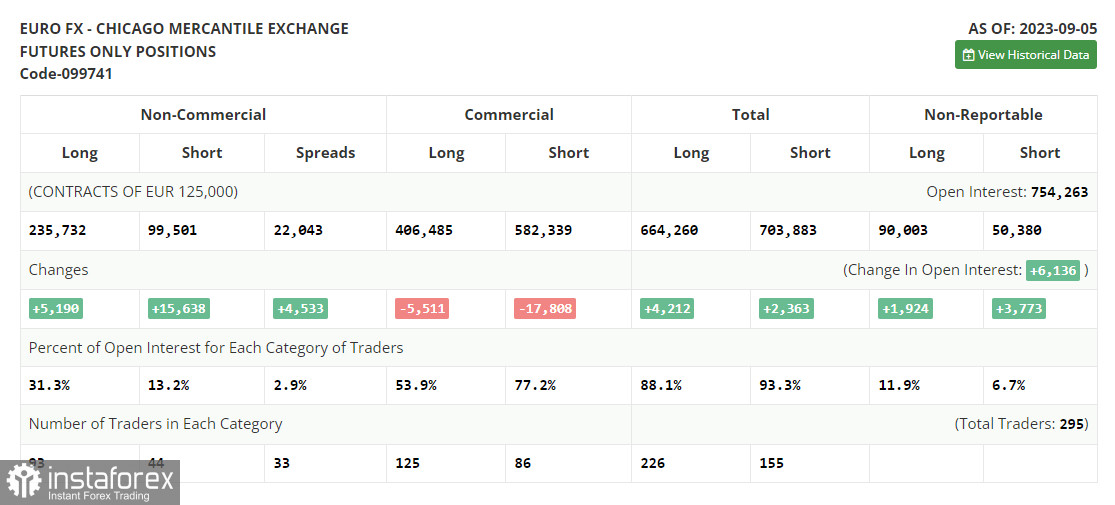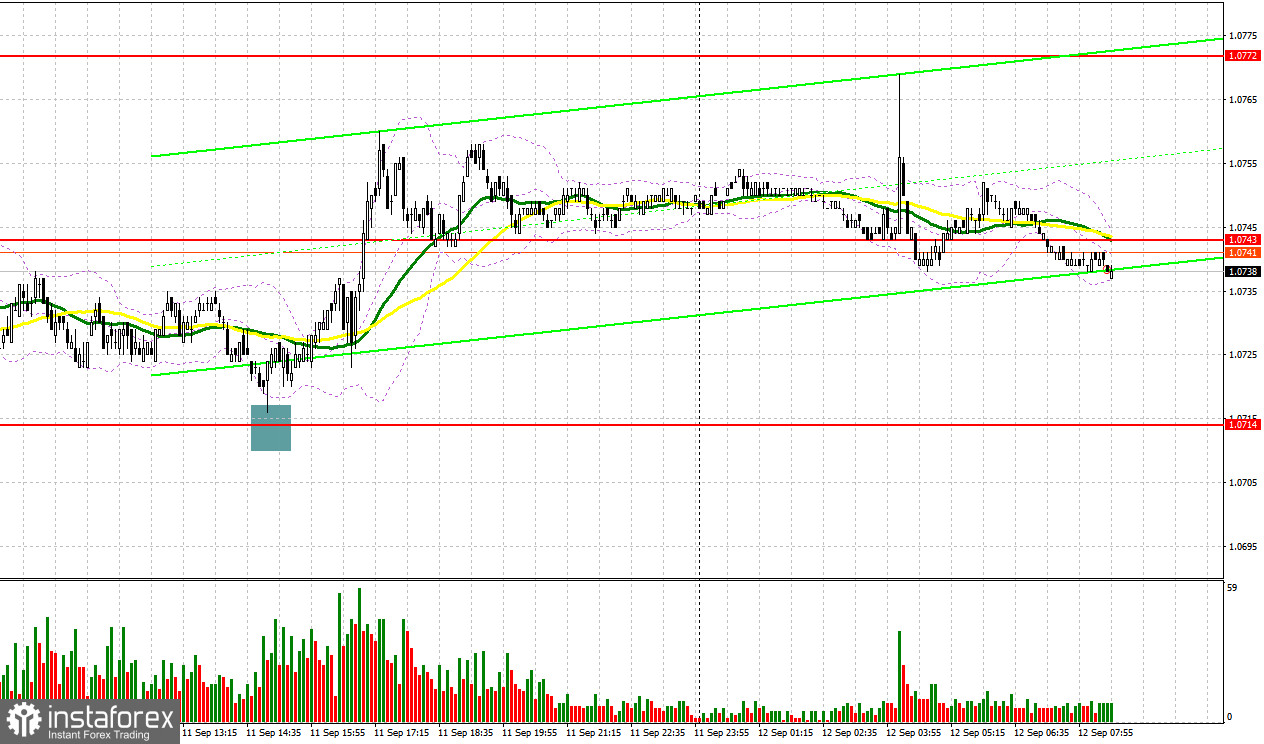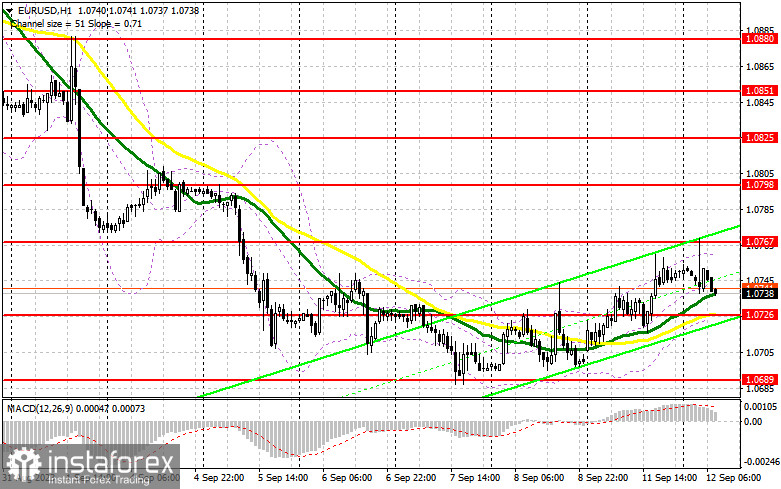Yesterday, only one entry signal was formed. Let's have a look at the 5-minute chart and see what happened there. In my morning review, I mentioned the level of 1.0714 as a possible entry point. The pair did make a decline but due to low volatility and trading volumes, a false breakout was never formed. That is why I didn't get any entry signals. In the afternoon, the pair missed just a few pips to test the 1.0714 level. Those of you who hadn't opened long positions within the upward correction were actually right. Those who went long on the pair could get 30 pips in profit.

COT report:
Before diving into the prospects of the EUR/USD pair, let's explore the futures market and the recent shifts in the Commitments of Traders (COT) positions. The COT report for September 5 displayed an increase in both long and short positions. Pronounced negative shifts in the Eurozone's economic activity, coupled with downward revisions of the GDP data for the second quarter, have augmented short positions for the trading instrument. Amplifying this sentiment, statements from the Federal Reserve representatives hinting at potential rate hikes in the US explain why the US dollar is surging while the European currency is losing ground. In the immediate horizon, crucial US inflation figures are on tap, poised to influence the future course of monetary policy and affect the direction of EUR/USD. Notably, as the euro is declining, we can observe an increase in long positions, reflecting the improved appetite of risk-asset buyers at these comfortable price levels. The COT report shows that non-commercial long positions rose by 5,190 to 235,732, while non-commercial short positions surged by 15,638, reaching 99,501. Consequently, the spread between long and short positions expanded by 4,533. The closing price declined to 1.0728 from 1.0882, signaling a bearish market trend.

For long positions on EUR/USD
The euro's ongoing upward correction could conclude at any moment, especially given the upcoming release of the key data from the ZEW Institute concerning business sentiment today. The data, anticipated for both Germany and the Eurozone, is not expected to be positive. Therefore, I plan to act on the pair's decline after a false breakout around the newly formed support at 1.0726 from yesterday. This level also coincides with the moving averages favoring the bulls, which means this is a key level. The immediate target to look forward to is the resistance at 1.0726. A break above this range followed by a top-down test, amplified by strong Eurozone data, especially from Germany, could bolster the demand for the euro, possibly pushing it towards 1.0798. The most distant target remains the 1.0825 area where I intend to lock in profits. Should the EUR/USD pair decline and show no activity around 1.0726, bears will reclaim market control, and the bullish correction might lose momentum. Under such circumstances, only a false breakout around 1.0689 will give a buy signal. I will open long positions immediately on a bounce from 1.0665, considering an upward correction of 30-35 pips within the day.
For short positions on EUR/USD
Sellers assert their strength each time the euro makes a notable rise, indicating their presence in the market even before tomorrow's crucial US inflation report. Receiving weak Eurozone statistics today would be favorable for the bulls as it would allow them to defend the 1.0767 resistance level. A false breakout here would provide an entry point, with a possible fall towards the low of 1.0726, which serves as the midpoint of the short-term sideways channel. Only upon breaking and consolidating below this range, coupled with a bottom-up retest, do I anticipate another sell signal with a target of 1.0689, where stronger buyers are likely to emerge. The ultimate target lies at 1.0665, where I will be locking in profits. In the event of an upward movement in EUR/USD during the European session and the absence of bears at 1.0767, bulls will retain the upper hand. Under such developments, I will postpone going short until the price hits the new resistance at 1.0798. You can sell at this level but only after a failed consolidation. I will open short positions immediately on a bounce from the 1.0825 high, aiming for a downward correction of 30-35 pips.

Indicator signals:
Moving Averages
Trading above the 30- and 50-day moving averages indicates a possible rise in the pair.
Please note that the time period and levels of the moving averages are analyzed only for the H1 chart, which differs from the general definition of the classic daily moving averages on the D1 chart.
Bollinger Bands
If the pair declines, the lower band of the indicator at 1.0725 will act as support. In case of an increase, the upper band of the indicator at 1.0760 will serve as resistance.
Description of indicators:
• A moving average of a 50-day period determines the current trend by smoothing volatility and noise; marked in yellow on the chart;
• A moving average of a 30-day period determines the current trend by smoothing volatility and noise; marked in green on the chart;
• MACD Indicator (Moving Average Convergence/Divergence) Fast EMA with a 12-day period; Slow EMA with a 26-day period. SMA with a 9-day period;
• Bollinger Bands: 20-day period;
• Non-commercial traders are speculators such as individual traders, hedge funds, and large institutions who use the futures market for speculative purposes and meet certain requirements;
• Long non-commercial positions represent the total number of long positions opened by non-commercial traders;
• Short non-commercial positions represent the total number of short positions opened by non-commercial traders;
• The non-commercial net position is the difference between short and long positions of non-commercial traders.
 English
English 
 Русский
Русский Bahasa Indonesia
Bahasa Indonesia Bahasa Malay
Bahasa Malay ไทย
ไทย Español
Español Deutsch
Deutsch Български
Български Français
Français Tiếng Việt
Tiếng Việt 中文
中文 বাংলা
বাংলা हिन्दी
हिन्दी Čeština
Čeština Українська
Українська Română
Română

